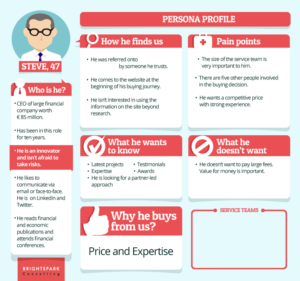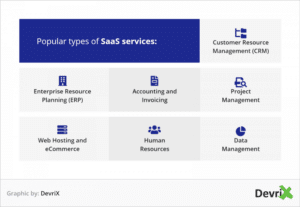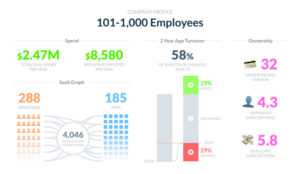Before you go to market, you gotta know your Buyer Personas. You know, what your B2B buyer looks like.
I’ll bet you have something like this written down somewhere, if you’ve hired full-time marketers at your company:
- Avatar: HR Heather
- Company Size: 500 – 5,000 employees
- 5+ open job postings
- 15%+ y/y employee growth
- Located in United States, especially large metro areas, but has international locations too
- Mostly Director/VP/CxO of HR/Recruiting
…etc.
And that’s all great! Now, how do you take this concept and apply it cleanly to outbound prospecting?
How should your sales development team go after the VP HR of a 520-person company differently than the Recruiting Manager at a 4,200-person company?
What Is a Buyer Persona?
A buyer persona (or marketing persona) is a semi-fictional representation of your ideal customers. It tells you who your primary customers are and all the information about them (e.g., demographics, interests, pain points, etc.). Here is what a buyer persona looks like:

You need to collect the data to create buyer personas. It can’t be based on your judgment; rather, it has to be data-driven and accurate. Once you have developed buyer personas for your target market, you’ll be able to create highly targeted content and all types of marketing collateral.
For example, a buyer persona will tell you what type of content to create, what format it should have, where to promote it, and how to address the problem of your ideal customers. You’ll have all this information available 24/7 with you in the shape of buyer personas.
Data is the crux of a buyer persona. The more data you have, the better. There are two major ways to collect data for buyer personas:
- Market research:includes data collection from your target audience and customers via surveys, focus groups, interviews, and other methods
- Analytics and insights:includes behavioral and non-behavioral data that you collect via analytic tools such as Google Analytics, CRM too, heatmaps, etc.
You need to use data from these two (and other sources) to develop buyer personas for your SaaS and tech brand.
Why Tech and SaaS Brands Should Care About Buyer Personas
All types of companies should use buyer personas and this includes SaaS and tech companies. The key benefits of using buyer personas include:
- Improved targeting
- Personalization and better UX and CX across all channels
- Increased conversions, sales, and revenue
- High customer engagement
- Increased reorder value and CLV
- Business growth
The formula is simple: The more you know your customers, the more you’ll earn.
However, the need for having updated buyer personas is way higher if you have a tech or a SaaS brand. Here are the key reasons:
Business Model
SaaS and tech business models are often quite similar, yet different from most other businesses. Both tech and SaaS brands rely heavily on recurring payments and customer retention. This is because they use subscription pricing to offer their services:

Think of Microsoft, Google, Salesforce, or any other leading company. They all have one thing in common: recurring payments.
This is exactly the opposite of ecommerce and other business models where they don’t rely on recurring payments. If you visit Amazon and buy your favorite furniture, you don’t have to pay a monthly subscription.
This means SaaS and tech brands have to put in extra effort to understand their customers and their complete journey to retain them for months and years. This also means you have to constantly update buyer personas since customer needs change quickly these days.
When your business relies on recurring payments, buyer personas can help you fully understand your buyer needs and preferences. This helps reduce the churn rate.
High Competition
The competition in the tech and SaaS industry is fierce. Every other startup is a SaaS company. It is estimated that an average company uses up to 137 SaaS apps:

Competing in such an environment isn’t easy. One mistake, and you’ll be replaced.
The solution?
You need to make sure you are doing much better than your competitors, especially in terms of customer experienceand personalization. You need buyer personas to improve customer experience and offer your customers a personalized experience every time they interact with your product or brand.
You need to develop a competitive edge to survive in today’s tech and SaaS market and the best way to do it is by leveling up your customer experience game. And this is where the buyer persona holds a key place.
It is safe to say that it is extremely challenging for a tech or SaaS brand to compete without a clear understanding of its customer needs, interests, and preferences.
Turbulence
The technology and SaaS sector is highly turbulent. New research, updates, upgrades, and technology shifts instantly change customer preferences and requirements. Technological changes and a relevant shift in customer demands force tech and SaaS brands to keep updating their products.
This requires constant communication with your customers and understanding their rapidly changing needs. What features they want, what new problems they’re facing, what alternative products they’re considering and why, and how their needs will shift in a couple of years from now.
These are a few questions that you need to answer to stay in business.
This all shows the importance of constantly updating your buyer personas. You need to collect data from your customers, add it to the buyer persona, and communicate the same to your product development team.
Your customers could be your best friend or worst enemy in such a rapidly changing environment. Understand their needs and offer them what they’re interested in, and you’ll be all set for growth.
Otherwise, customers will stop using your product after a few months (21 percent of users abandon an app after just one use) and switch to a better alternative.
Buyer Persona Template for Tech and SaaS Companies
So, how do you create a buyer persona for your tech and SaaS company?
It’s all about data.
As discussed above, you need to collect data from your customers and use your analytics tools to fill out the buyer persona template. Create at least one buyer persona for one target group.
It is also essential to link buyer personas to the buyer journey. In order to retain your customers and recurring payments, you must know the specific needs and interests of your ideal customers throughout the sales funnel.
It’s critical for SaaS and tech brands to have buyer personas aligned with the buyer journey stages. You must know how buyer preferences and interests change over time. For instance, a company selling 3pl software should understand how buyer needs evolve from initial research (e.g., integration capabilities) to final decision-making (e.g., ROI and automation features.)
As a growth marketing agency, we create detailed buyer personas (often multiple variations) and then create high quality content to nurture our clients customers through each step of the buyer’s journey.
Getting Granular with a Persona Matrix
In reality, your total customer segment can probably be distilled into a number of separate buyer personas, each of which should be spoken to differently when prospecting. My preference is to map this out in a simple spreadsheet, which your team can then review and approve. Your lead generation team will love it. You can also use this to easily set up your sales acceleration platform of choice, like Nova, which has a feature specifically for this. Other common choices include Outreach.io or Salesloft.
Here’s a screenshot of what that looks like (heavily simplified):

Your complete persona is going to be much more granular and detailed than this. But this is the high level: this is basically what you can give to your lead generation team, when you need them to generate lists of Accounts and Contacts you want to go after.
Writing Persona-Specific Sales Emails
Now, your job is to speak to each of these personas differently. Instead of writing a single outreach sequence, you’re going to write 6. Or, at least, you’ll configure your sales acceleration tool to automatically frame the introductory credibility statement and the value proposition differently, based on who you’re reaching out to.
For example, maybe the CEO and CHRO always care about getting interviewing & hiring done more quickly, though the CHRO also cares about compliance, whereas the Director of HR mostly is concerned about workplace culture fit when it comes to new hires. The HR Manager and Talent Manager just want their day-to-day lives to be easier, and may be willing to refer you to the decision-maker if shown a compelling value proposition.
This means you need to write a value proposition related to:
- Decreasing time to hire
- Ensuring hiring process legal compliance
- Improving culture fit
- How front-line managers can save time
Then, you have to set it up so that you’re delivering the right value statements to the right audience with your software.
What’s the result of all this?
You’re delivering a relevant message to the right person! You’re one step closer to achieving personalization at scale!
If this sounds complicated and you want help making it happen, reach out to us and we’ll lend a hand.




